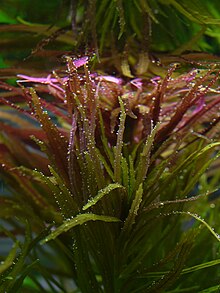
Zingiberaceae or the ginger family is a family of flowering plants made up of about 50 genera with a total of about 1600 known species of aromatic perennial herbs with creeping horizontal or tuberous rhizomes distributed throughout tropical Africa, Asia, and the Americas. Many of the family's species are important ornamental, spice, or medicinal plants. Ornamental genera include the shell gingers (Alpinia), Siam or summer tulip, Globba, ginger lily (Hedychium), Kaempferia, torch-ginger Etlingera elatior, Renealmia, and ginger (Zingiber). Spices include ginger (Zingiber), galangal or Thai ginger, melegueta pepper, myoga, korarima, turmeric (Curcuma), and cardamom.
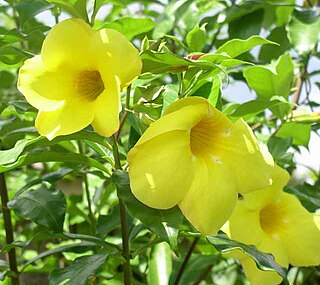
Allamanda is a genus of flowering plants in the family Apocynaceae. They are native to the Americas, where they are distributed from Mexico to Argentina. Some species are familiar as ornamental plants cultivated for their large, colorful flowers. Most species produce yellow flowers; A. blanchetii bears pink flowers. The genus name Allamanda honors the Swiss botanist and physician Frédéric-Louis Allamand (1736–1809). It is the official flower of Kuching North City Hall.

Catharanthus is a genus of flowering plants in the family Apocynaceae. Like the genus Vinca, they are known commonly as periwinkles. There are eight known species. Seven are endemic to Madagascar, though one, C. roseus, is widely naturalized around the world. The eighth species, C. pusillus, is native to India and Sri Lanka. The name Catharanthus comes from the Greek for "pure flower".
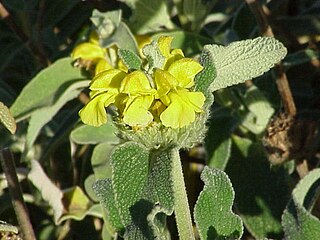
Phlomis is a genus of over 100 species of herbaceous plants, subshrubs and shrubs in the family Lamiaceae, native from the Mediterranean region east across central Asia to China.

Adenophora is a genus of flowering plants in the family Campanulaceae, the bellflowers. Plants of this genus are known commonly as ladybells. Most are native to eastern Asia, with a few in Europe. Many are endemic to either China or Siberia.
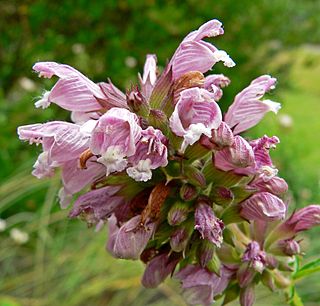
Cedronella is a genus of flowering plants in the tribe Mentheae of the family Lamiaceae, comprising a single species, Cedronella canariensis, native to the Canary Islands, the Azores, and Madeira. It is also naturalized in various places. Common names include Canary Islands-balm, Canary balm, and Balm-of-Gilead.

Cabomba is an aquatic plant genus, one of two belonging to the family Cabombaceae. It has divided submerged leaves in the shape of a fan and is much favoured by aquarists as an ornamental and oxygenating plant for fish tanks. Use in the aquarium trade has led to some species being introduced to other parts of the world, such as Australia, where they have become weeds.

Gentianella is a plant genus in the gentian family (Gentianaceae). Plants of this genus are known commonly as dwarf gentians.
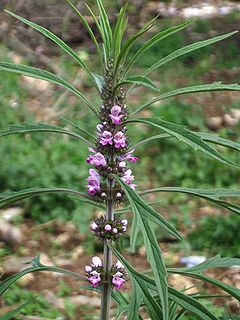
Leonurus sibiricus, commonly called honeyweed or Siberian motherwort, is an herbaceous plant species native to China, Mongolia, and Siberia. It has verticillaster inflorescence. It is naturalized in many other parts of the world, including South, Central and North Americas.

Goodenia is a genus of about two hundred species of flowering plants in the family Goodeniaceae. Plants in this genus are herbs or shrubs, mostly endemic to Australia. The leaves are variably-shaped, the flowers arranged in small groups, with three or five sepals, the corolla bilaterally symmetrical and either fan-shaped with two "lips" or tube-shaped. The petals are usually yellow to white, the stamens free from each other and the fruit a capsule.

Aloysia is a genus of flowering plants in the verbena family, Verbenaceae. They are known generally as beebrushes. They are native to the Americas, where they are distributed in temperate climates, as well as in subtropical and desert climates. The genus is named for Maria Luisa of Parma (1751-1819), wife of King Charles IV of Spain.

Cabomba caroliniana is an aquatic perennial herbaceous plant native to North and South America.
Plectocomiopsis is a dioecious genus of flowering plant in the palm family found in Indochina, Malaysia, Borneo and Sumatra. Hapaxanthic and armed with spines, they are a climbing rattan, closely related to the Myrialepis palms. The name is Greek for "similar to Plectocomia", another close relative.
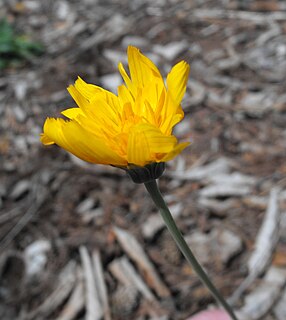
Krigia is a genus of North American flowering plants in the dandelion family. Plants of the genus are known generally as dwarf dandelions or dwarfdandelions.
Scutellaria bolanderi is a species of flowering plant in the mint family known by the common name Sierra skullcap. It is endemic to California, where it is known from the Sierra Nevada and several of the mountain ranges to the south. It is a perennial herb producing an erect stem or cluster of stems 30 centimeters to one meter tall from a system of thin rhizomes. The stems are coated in short, spreading hairs which sometimes have resin glands. The oval or heart-shaped leaves have wavy edges and are oppositely arranged. The lowest leaves are borne on short petioles. Flowers emerge from the leaf axils. Each flower is held in a calyx of sepals with a large ridge or appendage on the upper part. The corolla is between 1 and 2 centimeters long and tubular in shape with a large upper and lower lip. The upper lip is folded into a beaklike protrusion and the lower has three wide lobes. The corolla is white or very pale blue with an area of blue mottling on the lower lip.
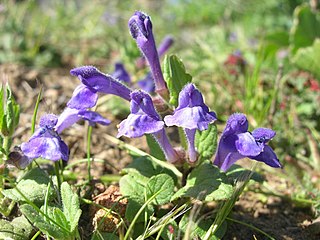
Scutellaria tuberosa is a species of flowering plant in the mint family known by the common name Danny's skullcap. It is native to western North America from Oregon through California to Baja California, where it is widespread throughout the mountain and coastal regions; it is absent from the deserts and the Central Valley of California. It can be found in forest and woodland habitat, and a variety of open habitat types, often appearing in areas recently cleared by wildfire. It is a perennial herb producing an erect stem or cluster of stems up to about 25 centimeters tall from a root system with tubers. The stems are coated in short, spreading hairs. The oval leaves are oppositely arranged. The lowest leaves are borne on short petioles. Flowers emerge from the leaf axils. Each flower is held in a calyx of sepals with a large ridge or dome-shaped appendage on the upper part. The tubular corolla is one to two centimeters long and has a large upper and lower lip. The upper lip is folded into a beaklike protrusion and the lower has three wide lobes. The corolla is deep purple-blue, usually with a white patch or mottling on the lower lip.

Leucas aspera is a plant species within the genus Leucas and the family Lamiaceae. Although the species has many different common names depending on the region in which it is located, it is most commonly known as Thumbai or Thumba. Found throughout India, it is known for its various uses in the fields of medicine and agriculture.

Cyclachaena xanthiifolia, known as giant sumpweed, or rag sumpweed is a North American plant species in the sunflower family, Asteraceae. It is the only species in the genus Cyclachaena. Giant sumpweed is believed to be native to the Great Plains but is now found across much of southern Canada and the contiguous United States, though rarely in the Southeast.

Chionophila tweedyi, or Tweedy's snowlover, is a perennial herb in the plantain family. It is native to Idaho and Montana in the western United States.

Ruspolia is a genus of flowering plants belonging to the family Acanthaceae.
